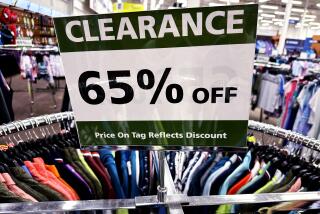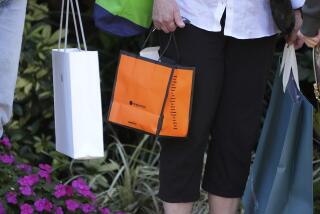Retail sales rise more than expected in February
With the first hint of spring sunshine last month, shoppers began emerging from hibernation, fueling hopes that a particularly bitter winter was to blame for the sour economic signals of recent months.
Retail sales rose 0.3% to $427.2 billion in February from the previous month, marking the first increase in the gauge since November, according to the Commerce Department.
The measure is considered a key indicator of economic health because consumer spending accounts for more than two-thirds of economic activity.
“The weather by almost any measure was severe,” said Standard & Poor’s analyst Bob Schulz. “As the weather becomes a little more normal, most of the consumer base is feeling better.”
Stocks are up so far this year, though the market has been volatile. Home prices are improving. Household wealth for the middle to upper end of the income spectrum “is back to pre-crisis levels or better,” Schulz said.
But lower-income Americans are still in a rut. Cuts to a government food stamp program in the fall continue to sting.
“It’s sort of a barbell effect, where the upper end feels much better while the lower end hasn’t really benefited from how far we are in the recovery,” Schulz said.
Still, the Labor Department unveiled promising numbers for the job market Thursday, showing that new filings for unemployment benefits dropped 9,000 last week to a 3-month low.
Sliding gasoline prices also helped. Although Americans spent 0.1% more at gas stations in February compared with January, sales plunged 4.8% from February 2013, according to the Commerce Department’s Thursday report on retail sales.
A gallon of gasoline cost an average of $3.50 nationwide Thursday, compared with nearly $3.71 a year earlier, according to the AAA Daily Fuel Gauge Report.
Sales in the non-store segment, which includes online sales and is not as influenced by weather as brick-and-mortar vendors, surged 6.3% from February 2013, the government said.
The clothing and accessories category, which had lagged behind during the holidays because of heavy storms and lack of innovation, enjoyed a 2.6% upswing year over year.
And in anticipation of warmer weather, sales of building materials and garden supplies rose 0.3% month to month and 3.2% from February 2013.
Los Angeles resident Mary D. Simon, 71, spent $2,250 at Home Depot last month. The legal assistant remodeled her bathroom, buying a new vanity and toilet as well as ceramic tiles and side lights.
But home improvement projects aside, she doesn’t do much shopping, she said.
“I only replace things,” she said, strolling through a Sawtelle shopping center while waiting to pick up her grandson from soccer practice. “Otherwise, I usually just go to Macy’s at Christmastime and get it all done there.”
The National Retail Federation said in a statement that “the economy is primed for growth.” The trade group said it expects pent-up demand to boost spring sales.
“Retailers and consumers endured the harsh winter and they’re hoping both the natural and man-made obstacles to growth will leave with the snow,” Matthew Shay, the group’s chief executive, said in a statement.
But the retail sales report left some analysts concerned.
“Taken at face value, the underlying trends and momentum measures are poor,” Credit Suisse researchers wrote in a note to clients.
Though February’s 0.3% uptick beat expectations for a 0.2% increase, “downward revisions nullified that minor surprise,” researchers wrote.
The government adjusted January’s sales, initially reported as a 0.4% decline, down to a 0.6% slide from December. And February sales were up only 1.5% year over year, the lowest growth rate since 2009.
Excluding the more volatile effects of motor vehicles and parts sales, retail sales rose 0.3% from January and 1.3% from a year earlier.
Electronics and appliance stores suffered, slumping 0.2% from January and 2.4% from a year earlier. Shoppers spent 5.2% less year over year at sporting goods, hobby, books and music vendors and cut purchases 4.8% at department stores.
“If frigid weather was not a credible explanation (we think it’s part of the story), these numbers would be disturbing,” Credit Suisse researchers wrote. “The real test will be the magnitude of any March/April springtime rebound.”
Twitter: @tiffhsulatimes







